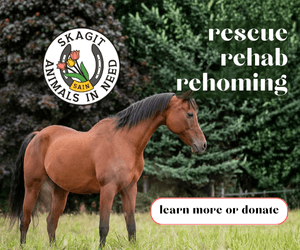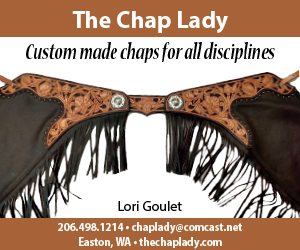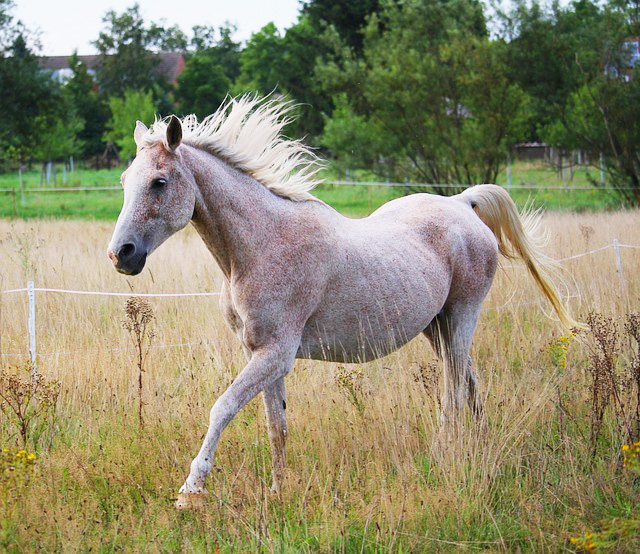By Juliet M. Getty, Ph.D.
Let me tell you about Bugsy. He was an Appendix Quarter Horse I rescued a few years ago. When he came to me, he was significantly underweight, suffered from an old stifle injury, and had a distrustful attitude. A few months later, he’d filled out, was running up and down hills with ease, and showed the curiosity and warmth of a youngster. How old was he? 25. Not old by today’s standards and yet, definitely up there. What made the difference? Nutrition played a big part in his improvement.
Advances in veterinary medicine and greater attention to nutrition have made it possible, and even probable, that your horse will live well into his 30s and even the 40s or older. Individuality plays as much a role in the way horses age as it does for us. There are fairly predictable changes, however, that go along with growing old, no matter at what age they become noticeable. Some horses have trouble gaining weight, others become too fat. Teeth wear down, making chewing difficult; some may even lose teeth. Most horses experience a decline in immune function and get sick more easily or develop allergies. Muscle mass may diminish and joints can become stiff. Digestion and absorption efficiency declines.
All these changes come about gradually, but as your horse starts to show signs of aging, the diet you’ve been feeding may now be obsolete. It may be time adjust it to meet your horse’s needs.
While the scope of this article is limited, you’ll find more detailed information in my book, Feed Your Horse Like A Horse, as well as in the Spotlight on Equine Nutrition series book, The Aging Horse. Here are some highlights…
There are two major changes to consider:
- Saliva production diminishes. A senior-friendly diet takes into account your horse’s reduced saliva production, which makes dry food difficult to chew and nearly impossible to swallow. This natural aspect of aging is easy to manage by simply moistening your horse’s feed; he’ll appreciate having his meal a little on the mushy side. And be sure there is water close by.
- Digestion efficiency is not what it once was. This leads to diarrhea, electrolyte imbalances, and weight loss. It starts in the small intestine where your horse produces fewer digestive enzymes, leading to malnutrition simply because his tissues never receive the nutrients from his meal. Plus, undigested food enters the hindgut where it is either fermented (which can lead to colic or laminitis) or ends up in the feces.
To improve the diet, follow these guidelines:
- Choose senior feeds. Senior feeds are pre-cooked and extruded (formed into kibbles) that are easy to chew and digest. Many senior feeds add digestive enzymes to their formulas to further assist with digestion. They also contain vitamins and minerals, but keep in mind that the only way your horse will get enough of these nutrients is if you feed the recommended amount.
- Or choose beet pulp or hay pellets. Moisten these feeds into a mush. You’ll want to add a digestive enzyme supplement, along with proper vitamin/mineral supplementation.
- Feed the hindgut microbial population. These microbes are responsible for digesting fibrous portion of the diet, providing your horse with calories. They are also necessary for B-vitamin production and maintaining a healthy immune function. Their numbers can significantly diminish due to several causes, such as stomach acid reaching the hindgut because of an empty stomach or inadequate saliva production (saliva neutralizes acid), pain and mental stress, illness, or administering antibiotics. Pro- and prebiotics are often added to senior feeds or supplements designed for aging horses.
- Include a source of omega 3s. They support immune function, reduce the inflammation of aging joints and muscles, regulate blood insulin levels, promote healthy skin and hooves, and improve attitude. Stabilized flaxseed meal (that has added calcium to correct for high phosphorus levels) and chia seeds are excellent sources of omega 3s. They are well tolerated and easy to feed.
- Supplement vitamin C. Vitamin C is necessary for collagen production (protein found in bones, joints, and blood vessels). It is also a potent antioxidant and natural antihistamine. When young, your horse was capable of producing his own vitamin C. Now that he’s getting older, he’s losing that ability. He’ll get ample vitamin C from fresh pasture, as long as it is lush; but hay has virtually no vitamin C.
- Supplement vitamin D during winter or when stalled. Your horse can produce vitamin D from sunlight but during the winter months or if your horse is not exposed to at least 8 hours of sunlight each day, be sure there is enough vitamin D in your commercial feed or supplement. This vitamin (along with vitamin C) will help keep your horse’s bones, muscles, and teeth in top shape.
- Avoid high starch feeds. Cereal grains (oats, corn, barley, etc.) and feeds made from cereal grains should be eliminated from the diet. As horses age, they are more inclined to become insulin resistant and may start to exhibit signs of equine Cushing’s disease.
A few words about weight…
Many horses gain weight as they age. This has to do with his sluggish metabolic rate. If he has weight to lose, he doesn’t really need anything other than pasture and hay except for a small, low starch meal each day to serve as a carrier for supplements such as flaxseed meal, vitamin C, and a comprehensive vitamin/mineral supplement. But never restrict forage — he needs to be able to graze all the time. Going for hours without eating will, ironically, prevent him from burning fat and he’ll remain heavy.
The underweight horse can be very challenging. First, try to determine the reason for weight loss. Worm infestation, ulcers, infections, liver or kidney disease, even cancer can cause weight loss. Pain and mental stress can also make it difficult for your horse to hold a normal weight. The most common reason for weight loss in older horses, however, is poor teeth. Soaked hay cubes or chopped forage, fed free-choice, will meet forage requirements. Extra calories can be provided in a variety of ways, but avoid cereal grains. Horses are more prone toward developing Cushing’s disease as they age and should be fed a low starch diet. Additional fat through flaxseed meal and rice bran are safer ways to help your horse gain weight without the risk of starch. Additional protein from alfalfa will boost protein quality to help maintain muscle mass, while adding extra calories. A good pre/probiotic will allow for more calorie production from the hindgut microbes.
Other age-related problems
- Joint and muscle deterioration. Most, if not all, horses over the age of 20 will develop arthritis to some degree. Stall confinement makes arthritis worse and makes muscles tight. Mild exercise helps lubricate stiff joints and builds up surrounding muscles. Even if you don’t ride your horse, the more pasture turnout he gets the better off he’ll be.
- Tendons and ligaments lose elasticity over time and muscle mass starts to decline. There are several nutrients that I find helpful in boosting joint and connective tissue strength and lean body mass. These are gamma oryzanol; branched chain amino acids; vitamins B6, C and E.
Bottom line…
Your horse’s genetic background combined with his health status throughout his growing and adult years will influence how well he ages. If he was fed well all his life, with attention paid toward filling in nutritional gaps, he will likely live longer and with fewer ailments.
You are the best judge of how well your senior horse is aging. By keeping track of his weight, his eating habits, and his overall condition, you can make appropriate adjustments to his diet that will impact his health and overall quality of life.

Juliet M. Getty, Ph.D. is an independent equine nutritionist with a wide U.S. and international following. Her research-based approach optimizes equine health by aligning physiology and instincts with correct feeding and nutrition practices. Dr. Getty’s goal is to empower the horseperson with the confidence and knowledge to provide the best nutrition for his or her horse’s needs. Learn more at www.gettyequinenutrition.com.








